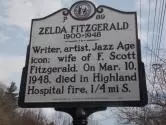Honoring Zelda

It was a rather unsettling holiday, if you could call it that.
March 10th had been unofficially deemed “Zelda Fitzgerald Day” here in Asheville, a holiday of sorts that was to be marked by readings at a local bookstore, a jazz band playing in one of the downtown bars, and women parading as 1920’s flappers.
However, March 10th was not Zelda Fitzgerald’s birthday.
It was the day on which she burned to death in a sanitarium here in Asheville.
The year was 1948, and Zelda was just 47 years old.
F. Scott Fitzgerald had brought Zelda to Asheville in 1936, where he had spent most of the past year dejectedly roaming around the Grove Park Inn, escaping a torrid love affair by racing down to nearby Hendersonville, or sequestered inside the Oak Hall Hotel in Tryon, an hour’s drive from Asheville. He had come south believing he had tuberculosis, when, in fact, he was simply losing his lifelong battle with alcohol addiction. Adding to his worries, his Jazz Age stories on which he depended for his living had fallen out of favor with an audience mired in the Great Depression, and now more apt to reach for a John Steinbeck or Ernest Hemingway novel.
Fitzgerald’s personal low point came in the fall of 1936 when in room 441 of the Grove Park Inn he attempted suicide, but, as his literary rival Hemingway enjoyed pointing out, Scott couldn’t even manage to do that correctly.
Zelda Fitzgerald had been institutionalized since 1930, when she suffered the first in a long series of nervous breakdowns. Her biographers now agree that had she been accurately diagnosed and properly treated, Zelda would have been saved years of suffering, but, instead, like many patients of that era, she had been subjected to questionable experimental treatments which did more damage than any imbalance she had arrived with.

Zelda, however, gradually recuperated here in Asheville, living in the women’s dormitory at Highland Hospital, located on a prominent knoll from which she could see the Grove Park Inn. Early in 1948 her physicians had, in fact, encouraged her to return to her childhood home in Montgomery, Alabama, where she moved back in with her mother.
But in the spring of 1948 Zelda voluntarily returned to Highland Hospital for additional treatment. She was sleeping in her top floor room that fateful night in March when a fire in the basement kitchen shot up the dumbwaiter shaft and quickly spread down the halls of the aging wooden structure. Nearly two dozen women made it safely out of the lower floors, but Zelda and eight other women were trapped in their upper rooms by the flames, and perished that night in the fire.
I had a meeting at the Grove Park Inn on Zelda Fitzgerald Day, so afterwards I took a slight detour home, driving through the Montford Historic District and onto the grounds of what had been Highland Hospital. The site of the terrible fire is now a peaceful, grassy knoll, marked with a plaque in her honor and a concrete bench offering a breathtaking view over downtown Asheville.
Given the local publicity Zelda Fitzgerald Day had garnered, I expected to find a few, if not several people enjoying a beautiful, sunny spring day as they paid their respects to the misbegotten Zelda.
Instead, the knoll was empty, leading me to hope it was just the site that had been forgotten and not Zelda herself.

Until next Monday,
“Mothers disapproved of their sons taking the Flapper to dances, to teas, to swim, and most of all to heart.” – Zelda Fitzgerald
Bruce
